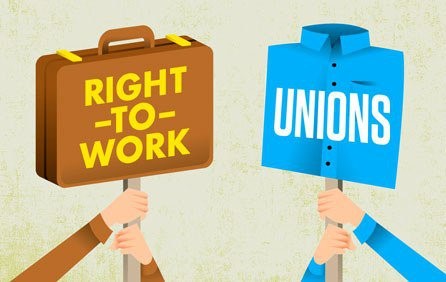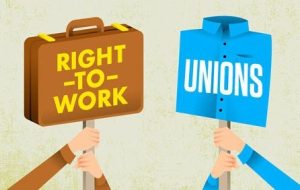Resolved: In the United States, right-to-work laws do more harm than good.
Definitions
As Makridis 19 explains, Right to work laws prohibit union security agreements between companies and unions, which means that employees in unionized workplaces are not required to pay for union representation.
Our Sole contentions is Right to work laws harm unions.
Under the National Labor Relations Act of 1935, all workers covered by collective-bargaining agreements receive the full benefits of those agreements. However, the Labor Management Relations Act of 1947, allowed states to introduce “right-to-work” laws under which covered workers cannot be legally required to pay union dues. These laws can create a “free-rider” problem in union membership, that is as noted by Gondhalekar 21, reaping the benefits of collective bargaining and protection against discrimination without paying the full price for it, undermining unions’ financing and ability to organize workers.
NBER 22 finds that right-to-work laws are associated with a drop of about 4 percentage points in unionization rates five years after adoption, as well as a wage drop of about 1 percent. The statistics worsens in another fives years where unionization is further reduced by 13 percentage points and wages by more than 4 percent.
Why is a weakened Union harmful?
Unions necessary to balance power relations between the employee and the employer. As explained by VanHeuvelen 20, Workers have significant power and economic disadvantages compared to employers and businesses over control of the distribution of economic resources, so they must organize in politics and workplaces to have a reasonable chance at higher pay, more generous benefits, and better working conditions.
Impact
- Improve wages – Workers with union representation enjoy a significant pay premium compared to non-union workers. The Bureau of Labor Statistics reports non-union workers earn just 83 percent of what unionized workers earn ($975/week vs. $1,169/week). US Department of Labor
- Union density – When more workers have unions, wages rise for union and non-union workers. The converse is also true: when union density declines, so do workers’ wages. Mishel 21 found the decline in unionization has cost the typical full-time, year-round worker $3,250 in lost earnings per year.
- Workplace safety – Zoorob 18 observes a one-percentage point increase in the unionized workforce associated with a 2.8% decline in the rate of occupational fatalities. By weakening unions, 14% increase in the rate of occupational fatalities. Between 1992 and 2016, 138,000 workers died in on-the-job accidents, coincided with the introduction of RTW laws.
- Reduce discrimination – Bivens 2017 Unions help raise women’s pay. Hourly wages for women represented by unions are 9.2 percent higher on average than for nonunionized women with comparable characteristics. Unionized black workers earn even more in some sectors. Unionized black construction workers in New York City earn 36.1 percent more than nonunion black construction workers in New York City.
- Healthcare & Insurance – Union representation offers greater access to, and participation in, employer-sponsored retirement plans. In fact, 93 percent of unionized workers in private industry have access to employer-sponsored retirement plans, compared to only 66 percent of non-union workers. Union workers participate in retirement plans at higher rates than non-union workers: 84 percent of unionized workers in private industry with access to retirement plans participate in those plans while only 49 percent of non-union workers who have access do. US Department of Labor
- The projections suggest that baby boomers are less likely than current retirees to have enough postretirement income to maintain their preretirement living standards. Over two-fifths of baby-boomer retirees will replace less than three-quarters of their preretirement earnings and almost a fifth will replace less than half of their preretirement earnings. The decline in replacement rates for baby-boomer retirees relative to those for current retirees is driven, in part, by a projected decline in Social Security replacement rates. Barbara 04
Citations
Makridis 19 (Makridis, C. A. (2019). Do Right-to-Work Laws Work? Evidence on Individuals’ Well-Being and Economic Sentiment. The Journal of Law and Economics, 62(4), 713–745. doi:10.1086/707081)
Gondhalekar 21 (Gondhalekar, Vijay B. and Kessler, Lara, (July 14, 2021). Right-to-Work Laws: A Brief Review. https://ssrn.com/abstract=3887029 http://dx.doi.org/10.2139/ssrn.3887029)
VanHeuvelen 20 (VanHeuvelen, T. (2020). The Right to Work, Power Resources, and Economic Inequality. American Journal of Sociology, 125(5), 1255–1302. doi:10.1086/708067)
US Department of Labor, https://www.dol.gov/general/workcenter/union-advantage#:~:text=Unions%20help%20reduce%20wage%20gaps,their%20rights%20in%20the%20workplace.
Mishel 21 (Lawerence Mishel (2021) The enormous impact of eroded collective bargaining on wages, Economic Policy Institute, https://files.epi.org/uploads/225389.pdf)
Zoorob 18, (Michael Zoorob, 9-25-2018, Scholars Strategy Network, “How Unions Help Prevent Workplace Deaths in the United States”, https://scholars.org/contribution/how-unions-help-prevent-workplace-deaths-united-states)
Bivens 2017 (Josh Bivens, “How today’s unions help working people,” 8/24/17, Economic Policy Institute, https://www.epi.org/publication/how-todays-unions-help-working-people-giving-workers-the-power-to-improve-their-jobs-and-unrig-the-economy/)
Barbara 04 (Barbara A. Butrica, The Changing Impact of Social Security on Retirement Income in the United States, Social Security Bulletin, https://citeseerx.ist.psu.edu/document?repid=rep1&type=pdf&doi=d1595aa588334dc03d2b82f0acaf90169fafae3f)






